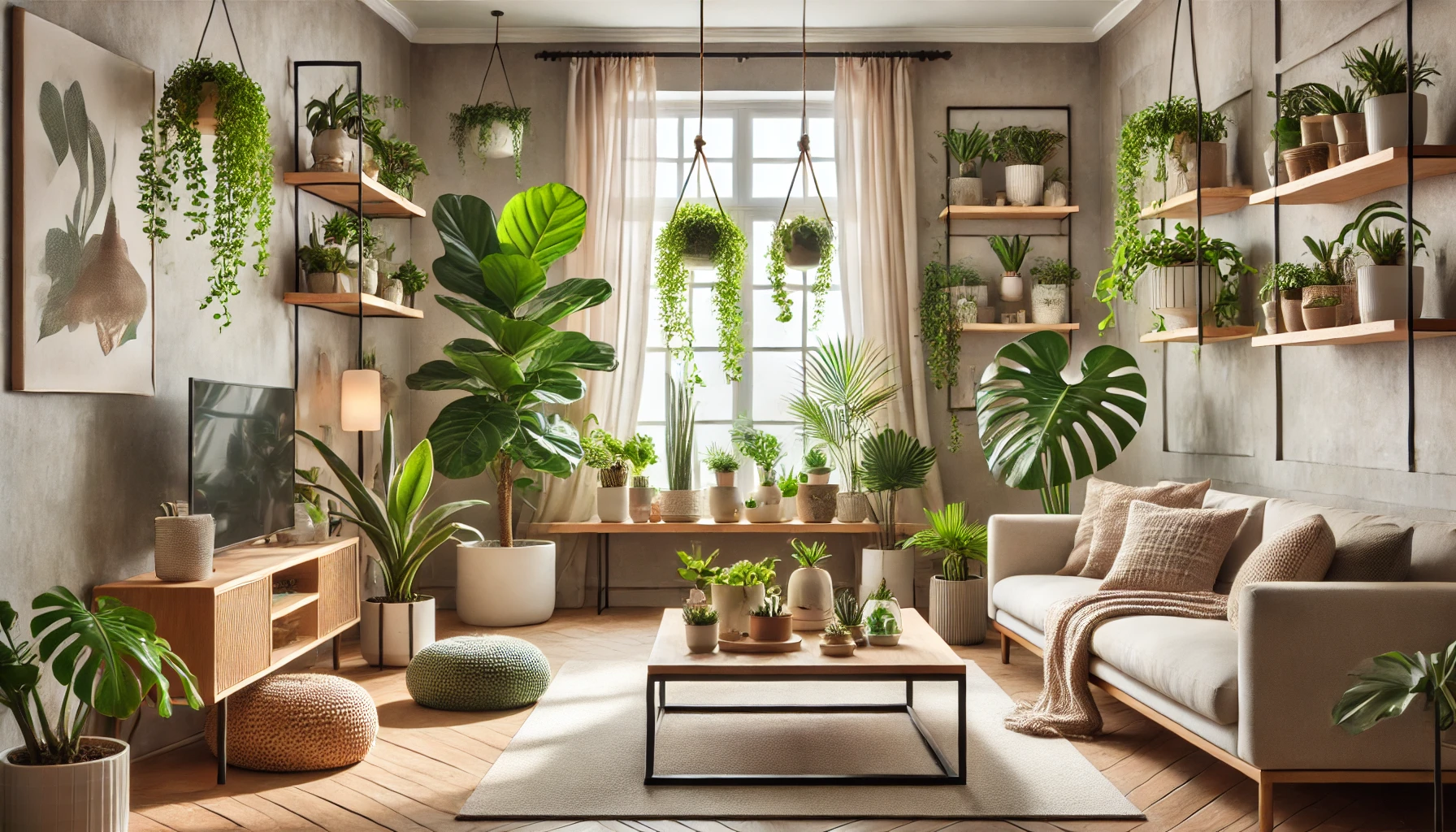Plants are an excellent way to enhance home decoration, adding freshness, texture, and natural beauty. Beyond aesthetics, indoor plants improve air quality and create a calming environment. Whether you prefer low-maintenance greenery or statement plants, this guide will help you choose the best options and keep them thriving.
1. Benefits of Decorating with Indoor Plants
Before choosing the right plants for your home, it’s important to understand the advantages they bring:
- Improved Air Quality: Many indoor plants filter toxins and increase oxygen levels.
- Enhanced Mood and Productivity: Greenery has been proven to reduce stress and boost focus.
- Aesthetic Appeal: Plants add life, color, and texture to any space.
- Increased Humidity: Some plants help balance indoor humidity levels.
Now, let’s explore the best plant options based on style and maintenance level.
2. Low-Maintenance Plants for Beginners
If you’re new to plant care or have a busy lifestyle, these easy-to-care-for plants are perfect:
1. Snake Plant (Sansevieria)
- Why It’s Great: Extremely hardy and requires minimal care.
- Light Needs: Tolerates low to bright indirect light.
- Watering: Water once every 2-3 weeks.
- Best Placement: Bedrooms, offices, and living rooms.
2. ZZ Plant (Zamioculcas zamiifolia)
- Why It’s Great: Thrives in low light and requires little water.
- Light Needs: Low to moderate indirect light.
- Watering: Water once every 2-3 weeks.
- Best Placement: Entryways, bathrooms, and corners with little sunlight.
3. Pothos (Epipremnum aureum)
- Why It’s Great: Fast-growing and can tolerate various conditions.
- Light Needs: Low to bright indirect light.
- Watering: Water when the soil is dry, about once a week.
- Best Placement: Hanging baskets, shelves, or trailing over furniture.
4. Peace Lily (Spathiphyllum)
- Why It’s Great: Elegant and purifies air.
- Light Needs: Low to moderate indirect light.
- Watering: Water once a week; prefers slightly moist soil.
- Best Placement: Bedrooms, bathrooms, and offices.
3. Best Statement Plants for Home Decoration
If you want plants that make an impact, consider these larger, visually striking options:
1. Fiddle Leaf Fig (Ficus lyrata)
- Why It’s Great: Tall, elegant, and trendy in modern decor.
- Light Needs: Bright, indirect light.
- Watering: Water once a week, keeping the soil slightly moist.
- Best Placement: Living rooms and open spaces with lots of natural light.
2. Monstera Deliciosa
- Why It’s Great: Unique, tropical leaves add a bold aesthetic.
- Light Needs: Bright, indirect light.
- Watering: Water when the top layer of soil is dry (about once a week).
- Best Placement: Corners of the living room or near windows.
3. Rubber Plant (Ficus elastica)
- Why It’s Great: Deep green leaves with a glossy finish.
- Light Needs: Medium to bright indirect light.
- Watering: Water when the soil is dry, about once every 7-10 days.
- Best Placement: Office spaces, living rooms, or hallways.
4. Areca Palm (Dypsis lutescens)
- Why It’s Great: Adds a tropical touch and purifies the air.
- Light Needs: Bright, indirect light.
- Watering: Water when the top inch of soil is dry.
- Best Placement: Open living areas, balconies, or near windows.
4. How to Care for Indoor Plants
Keeping your plants healthy involves more than just watering them. Here are essential care tips:
1. Understanding Light Requirements
- Low-Light Plants: ZZ Plant, Snake Plant, Peace Lily.
- Medium-Light Plants: Pothos, Rubber Plant.
- Bright-Light Plants: Fiddle Leaf Fig, Monstera, Areca Palm.
Place plants near windows with sheer curtains to filter direct sunlight if necessary.
2. Proper Watering Techniques
- Overwatering is the most common mistake—always check if the soil is dry before watering.
- Use pots with drainage holes to prevent root rot.
- Mist plants occasionally to maintain humidity.
3. Choosing the Right Pot
- Clay or Terracotta Pots: Absorb moisture and prevent overwatering.
- Plastic Pots: Retain moisture longer, ideal for dry climates.
- Self-Watering Pots: Great for beginners who may forget to water.
4. Fertilizing for Growth
- Use an all-purpose liquid fertilizer every 4-6 weeks during the growing season (spring and summer).
- Reduce feeding in fall and winter when plant growth slows down.
5. Pruning and Cleaning
- Remove yellow or dead leaves to encourage new growth.
- Wipe leaves with a damp cloth to remove dust and keep them shiny.
5. Styling Tips: How to Decorate with Plants
Indoor plants can be used creatively in home decor. Here are some styling ideas:
1. Hanging Plants for Small Spaces
- Use macrame hangers for trailing plants like Pothos or String of Pearls.
- Hang them near windows or from ceiling hooks to add greenery without taking up floor space.
2. Statement Plants in Corners
- Large plants like Monstera or Fiddle Leaf Fig fill empty corners beautifully.
- Place them in woven or decorative pots for an elegant touch.
3. Floating Shelves with Greenery
- Display small plants on shelves alongside books and decor items.
- Mix different plant types for variety in texture and color.
4. Plant Clusters for a Jungle Vibe
- Group plants of different heights together for a lush look.
- Use various pot colors and materials to enhance visual appeal.
5. Desk and Tabletop Plants
- Keep small, low-maintenance plants like Snake Plants or Peace Lilies on desks or coffee tables.
- Adds a refreshing and calming touch to workspaces.
Final Thoughts
Indoor plants are a simple yet effective way to elevate your home decor. Whether you choose low-maintenance greenery, bold statement plants, or a mix of both, the right selection can transform your space. By understanding light, watering, and styling techniques, you can create a vibrant, welcoming environment with plants that thrive.
So, go ahead and bring nature indoors—your home (and health) will thank you!
